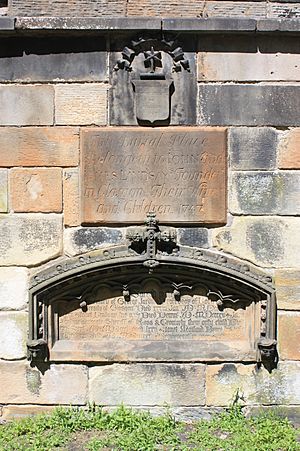George Jardine facts for kids
Rev George Jardine (born 1742 – died 1827) was an important Scottish minister, philosopher, and educator. He taught at the University of Glasgow for many years. First, he was a Professor of Greek starting in 1774. Later, from 1787 to 1824, he became the Professor of Logic and Rhetoric. George Jardine also helped start two important groups: the Royal Society of Edinburgh in 1783 and the Glasgow Royal Infirmary in 1792.
At the University of Glasgow, Jardine was a pioneer in a new way of learning called collaborative learning. This means students worked together to learn. He even wrote a book about his teaching methods. He created a system where students reviewed each other's work. He called these student reviewers "examinators." Jardine believed that working together helped students develop important social skills. These skills, he thought, were key for both studying science and for everyday life.
Contents
Life and Early Years
George Jardine was born in 1742 in a place called Wandel in Lanarkshire, Scotland. His family had lived there for almost 200 years. In October 1760, he left his local school to attend Glasgow College. He studied arts and divinity there, earning his Master of Arts degree in 1765. After his studies, he was allowed to preach as a minister.
In 1770, Jardine traveled to Paris to teach the sons of William Mure. While there, he met famous thinkers like David Hume. After returning from France in 1773, he tried to become a professor at Glasgow but narrowly missed out. However, in June 1774, he was appointed Professor of Greek. He also became an assistant professor in logic. When the main logic professor died in 1787, Jardine became the sole Professor of Logic.
Jardine's Innovative Teaching Methods
Jardine changed how logic was taught at the university. He made the classes more practical and introduced daily examinations. Because of his new methods, the number of students in his classes grew a lot. They went from about 50 students to nearly 200! He wrote down his teaching ideas in a book called Outlines of Philosophical Education, first published in 1818.
Jardine also created a new type of introductory college course. This course broke down difficult topics into smaller, easier-to-understand parts. This was much better than presenting everything at once. He believed that lectures should include regular tests to check student progress. Students also had to write essays and original papers.
His book, Outlines of Philosophical Education, Illustrated by the Method of Teaching the Logic Class at the University of Glasgow, became very popular. It was even used as a textbook in American colleges. The book explained how to create an exciting learning environment. It also promoted "writing across the curriculum." This meant students wrote compositions, essays, and research papers in every class. This helped students learn to think for themselves and write clearly.
Later Life and Contributions
In 1790, George Jardine had a country house built called Hallside, near Cambuslang. He also had rooms inside the university courtyard in town.
He was one of the people who helped start the Glasgow Royal Infirmary in 1792. For more than 20 years, he served as its secretary. He also represented the Hamilton church area in the General Assembly of the Church of Scotland for over 30 years. Jardine retired from his teaching role in 1824. He passed away on January 27, 1827.
He is buried in the Lindsay family plot near Glasgow Cathedral.
Family Life
In 1776, George Jardine married Janet Lindsay. She was the daughter of John Lindsay, a well-known founder in Glasgow. Janet passed away in 1815. They had one son, John Jardine. John became a lawyer and later held an important legal position. He died in 1850.
Both Janet and John are buried with George Jardine.
Legacy and Famous Students
George Jardine's ideas influenced many people. One notable person was Alexander Campbell, who founded Bethany College in West Virginia. Some of Jardine's famous students included Christopher North and Sir William Hamilton.
Artistic Recognition
A portrait of George Jardine, painted by John Graham-Gilbert, can be seen at the Hunterian Art Gallery in Glasgow. He was also painted by Thomas Hodgetts in 1827. Sir Henry Raeburn also painted Jardine, and he painted Mrs. Jardine too.


